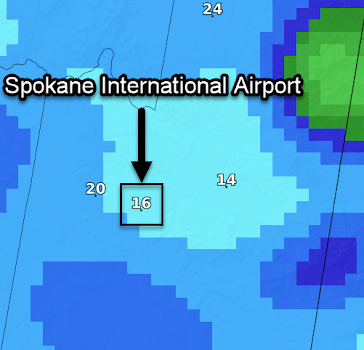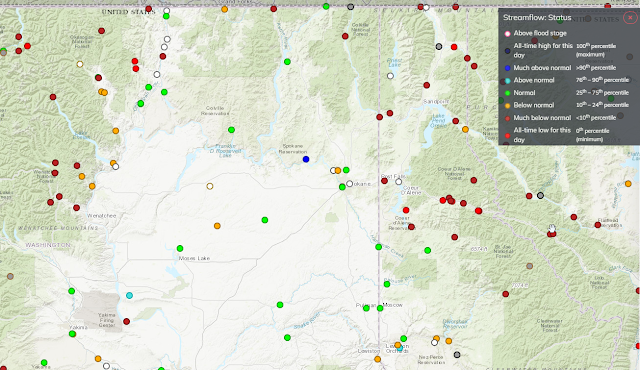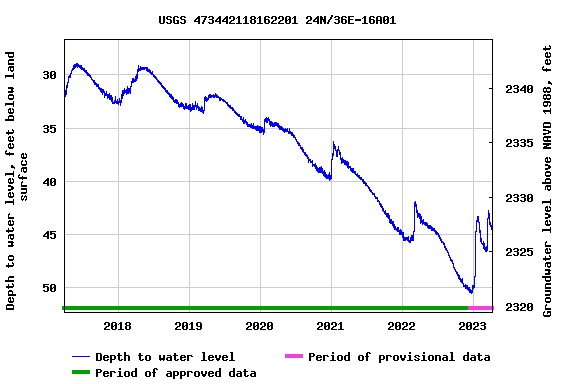***Updated Apr 24th with new forecast numbers***
Are you ready for warmer temperatures? A big change in the weather pattern is coming, bringing the warmest temperatures of 2023 so far for many locations. First lets take a quick peak of what has been going on this spring, and why it has been so cold.
Most days this spring have brought below normal temperatures. Below is a plot of temperatures in Spokane and Wenatchee since March 1st. The blue bars are observed values, with the brown shaded area normal values. As you can see, most days have been cooler than normal, with observed temperatures the past 30 days showing little in the way of warming despite the normal temperatures increasing.
 |
| Spokane (GEG) temperatures since March 1st. Blue bars are observed. Brown shading is the normal range. Top red line is record high values, while bottom blue line is record low values. |
 |
| Wenatchee (EAT) temperatures since March 1st. Blue bars are observed. Brown shading is the normal range. Top red line is record high values, while bottom blue line is record low values. |
Why has it been so cold? There has been a persistent trough over the region as noted by the dark purple shading on the map below over the Pacific Northwest.
 |
500mb temperature anomaly March 1st-April 19th, 2023
|
Significant changes are in the forecast. Here is a loop showing the weather pattern this week, with strong high pressure forecast to build over the western US, which will bring the warmest temperatures of 2023 so far.
 |
| Forecast weather pattern this week - showing 500 mb heights and anomaly through April 30th, 2023 |
How confident are we in the warming trend? For this answer our forecasters like to look at what are called "Box and Whisker Plots". This sophisticated method takes in what are called ensemble forecasts. Approximately 100 forecasts from various model ensemble forecasts compose these forecasts, giving forecasters an idea of the range in possible outcomes. Small boxes means generally higher confidence in the forecast due to a smaller range in values, while a wider range means less confidence. So what are the models showing for forecast temperatures this week for Spokane?
 |
| ***Updated Apr 24th*** GFS, ECMWF, and Canadian Models Box and Whisker Forecast for temperatures for Spokane, WA through May 2nd, 2023 |
The red boxes represent the high temperature forecast, with the boxes staying fairly small through Saturday, with high temperatures warming into the 70s. By next Sunday and especially Monday the boxes increase in size, leading to more possible outcomes and thus less confidence. You may be wondering what the vertical gray lines mean. These are the "whiskers" and represent the model solutions that are more extreme (both warm and cold) but are still important information for forecasters to consider.
But we have taken things even a step further. All the temperature forecast above are straight from the models, and have not gone through any sort of calibration. Why is this important? It's possible a model can have a persistent bias towards being too warm or too cold, which is important to try and alleviate. This is where the NWS relatively new set of forecasts come into play. Below is the calibrated version from the NWS NBM (National Blend of Models).
 |
| ***Updated Apr 24th*** National Blend of Models (NBM) Box and Whisker Forecast for temperatures for Spokane, WA through May 3rd, 2023 |
This pretty much says the same story, just with slightly different numbers and ranges. Increased box size later in the weekend into early next week means there is increased uncertainty out that far into the forecast.
Some may be saying "This is too complex, just tell me what the temperatures are going to be!" Well we can do that, but it's always good to have some background information into the forecast so you know how confident we are. Here is our forecast as of Sunday morning for the upcoming week.
 |
| ***Updated*** NWS Official Forecast Temperatures issued 3 AM PDT Monday, April 24th, 2023 |
The warmest temperatures of 2023 for many locations are forecast this week. How long will it last? This is unknown with a lot of model variability heading into next week. For the latest forecast, head to
https://www.weather.gov/spokane
















